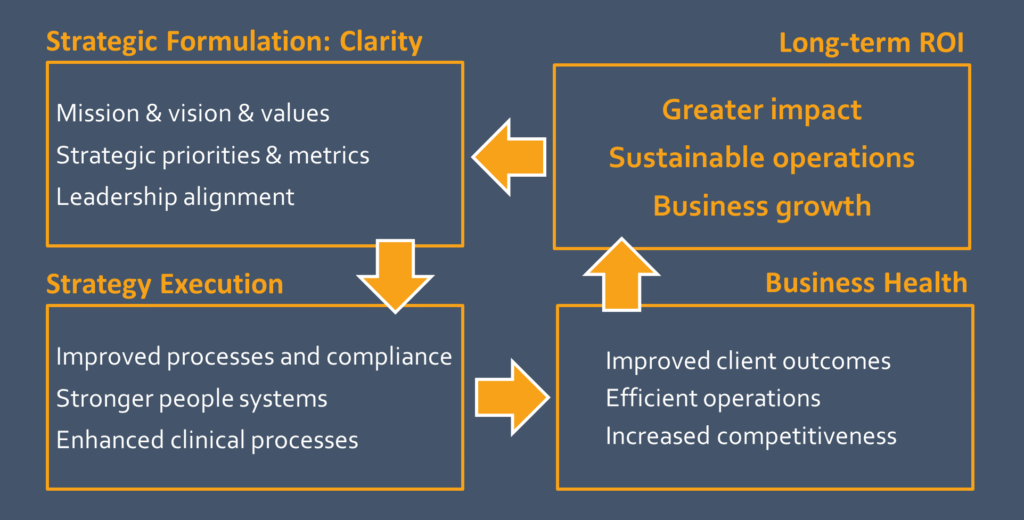You constantly invest in people, client facing technologies, such as tele-health. You invest in marketing, in your facilities, and in data analytics.
The desired return on these investments (ROI) is a more efficient organization that generates better clinical outcomes and is viable as a business.
There exists an investment that can help you make the most of your other investments. It might be something you haven’t thought about as an investment because it’s typically considered a cost item.
Strategic planning is an investment that helps you build a healthier and stronger organization.
It is a systems-level intervention that enables you to making strategic resource allocations. In other words, it guides you in deploying your people and financial resources where they matter most.
So how you do go from investment to business health?
Immediate ROI: Clarity
The immediate ROI is created during strategy formulation itself. As your leadership team engages in the planning process, they establish clarity on the foundational elements of strategy: the mission, vision, and core values of the organization (guiding principles).
Next, you create clarity with respect to your most important priorities: What challenges could keep you from achieving your vision? What can you do to overcome these challenges and move your business toward your vision?
You then develop strategies and metrics around the answers.
Strategy conversations not only create clarity around the most important aspects of your organization, they also align your leadership team around these priorities, around the goals, and around the guiding principles.

Strategy Execution
Strategy execution results in a number of short-term ROIs
Improved processes and greater compliance.
Stronger people systems are created as you communicate the guiding principles and embed them in your human systems – from recruiting, to hiring, to onboarding, development and coaching.
Research has shown that “companies that have clearly defined and communicated how they create value, 63% of employees say they’re motivated, versus 31% at other companies; 65% say they’re passionate about their work, versus 32% at other companies.”
In the process of strategy execution, you will be able to improve clinical processes systemically because you focus your operations on what matters the most. You are moving from putting out fires and tactical interventions to preventing fires.
You do so by creating more robust processes in a prioritized order determined during strategy formulation.
Business Health
As you implement your list of strategic priorities, you operational and clinical processes improve as your work out the your support systems. This creates the mid-term ROI.
Implementing operational interventions in a prioritized order leads to improved client outcomes and creates more efficient operations.
Having this priority adds tremendous value because you can leverage interventions such as organizational behavior management at a strategic rather than tactical level as they contribute to the overall vision of the organization rather than being an isolated or disconnected intervention.
Thus, the clarity created in strategy formulation helps you build a more competitive enterprise as you deliver more value to your client more efficiently than competitors.
Long-term ROI
The long-term impact of improved operations and clinical outcomes allows you to have a greater impact on the populations and communities you serve. Efficient operations and a steady supply of clients lead to more sustainable operations.
In addition, as you improve processes so they become more efficient and robust, they become more scalable and can be exported to other locations.
This provides the perfect foundation for growing your business, whether you do so organically or via acquisition.
Logic Model
The above diagram also works as a logical model when read backwards from long-term ROI to strategy formulation.
Creating a more sustainable and healthy organization requires stronger operational and clinical processes and are productive and innovative workforce. This, in turn, requires that you create clarity around your mission and vision and the strategies that help you achieve both.
Keep your strategy alive
High-performing businesses don’t rest on their accomplishments.
They regularly review and update their strategic priorities.
After two or three years, you review the assumptions created during your initial strategy formulation and refresh you strategies. That ensures that you are constantly growing, becoming an even stronger and healthier organization with even larger impact and business results.

